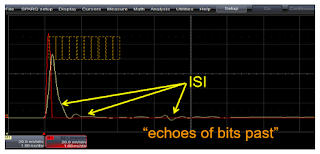 |
| Figure 1: Transmit pre-emphasis pre-distorts signals in anticipation of the channel's effects |
You need to test, we're here to help.
You need to test, we're here to help.
Showing posts with label ISI jitter. Show all posts
Showing posts with label ISI jitter. Show all posts
27 June 2018
Introduction to Channel Equalization
19 June 2018
Rise-Time Degradation and ISI Jitter
 |
| Figure 1: Shown are the signals from two extreme bit patterns overlaid on top of each other with no interconnect in the channel |
13 June 2018
Inter-Symbol Interference (or Leaky Bits)
 |
| Figure 1: Inter-symbol interference, or ISI jitter, is the result of information from one bit "leaking" to subsequent bits |
Subscribe to:
Posts (Atom)